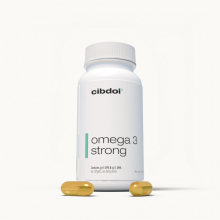What Foods Are High in Omega-6?
Published:
Omega-6 fatty acids are an essential type of polyunsaturated fat that the body needs but cannot produce on its own. While omega-6 fats are important for health, most modern diets contain too much of these inflammatory fats and not enough omega-3s. Achieving a proper balance between omega-6s and omega-3s is key for reducing inflammation and optimizing health.
Contents:
This article provides a comprehensive overview of the foods highest in omega-6, tips for limiting excess omega-6 intake, and the benefits of balancing your omega-6 to omega-3 ratio.

What Are Omega-6 Fatty Acids?
Omega-6 fatty acids, also known as linoleic acid or LA, are a family of polyunsaturated fats that are essential for human health. This means they must be obtained through the diet since the body cannot synthesize them on its own.
The main omega-6 fat is linoleic acid (LA), which can be converted into other omega-6 fats like gamma-linolenic acid (GLA) and arachidonic acid (AA). These omega-6 metabolites help regulate inflammation, blood clotting, and other bodily processes when consumed in moderation.
However, most modern diets provide a large excess of LA, causing an imbalance between omega-6 and omega-3 fatty acids. This can promote systemic inflammation, raise the risk of chronic diseases, and inhibit the benefits of omega-3 fats.
Top 10 Foods Highest in Omega-6 Fatty Acids
Many foods in the Western diet are high in omega-6 fatty acids, particularly processed foods made with vegetable oils. Here are 10 of the foods highest in omega-6:
1. Soybean Oil
Soybean oil is extremely high in LA, containing around 50g omega-6 fat per tablespoon. It’s commonly used for baking, frying, and in packaged foods.
2. Corn Oil
Corn oil provides around 40g of LA per tablespoon, making it one of the most concentrated sources of omega-6. It’s commonly used for frying and in margarine spreads.
3. Safflower Oil
With about 40g omega-6 fat per tablespoon, safflower oil is frequently used in salad dressings, mayonnaise, and cooking oils.
4. Sunflower Oil
Sunflower oil contains 30g of LA per tablespoon. It’s widely used in snacks, packaged foods and as a cooking oil.
5. Walnuts
Walnuts provide around 12g of omega-6 fat per ounce (28 grams). They’re a healthy omega-6 source but still contain more LA than ALA omega-3 fat.
6. Pine Nuts
Pine nuts offer around 10g of omega-6 fat per ounce. They’re rich in healthy fats but skew heavily toward omega-6s.
7. Pistachios
Pistachios contain around 8g of LA per ounce. They’re high in healthy monounsaturated fat but also provide excess omega-6 compared to omega-3.
8. Pecans
Pecans offer around 7g of omega-6 fat per ounce. They’re high in monounsaturated fat but have far more LA than ideal.
9. Poultry
Meat from chickens and turkeys provides 4–5g of omega-6 fat per 3-ounce serving. While not extremely high, poultry lacks omega-3s.
10. Pork
Pork contains 3–4g of omega-6 fat per 3-ounce serving. It provides omega-6 with little counterbalancing omega-3s.
As you can see, oils like soybean, corn and safflower oil provide a whopping amount of omega-6 per serving. Even healthy nuts and seeds like walnuts and pine nuts are skewed toward this inflammatory fat.
4 Tips to Limit Excess Omega-6 Intake
Because the typical Western diet contains far more omega-6 fats than optimal, limiting dietary sources of these fats is recommended. Here are some tips to reduce excess omega-6 intake:
- Use olive, avocado or coconut oil for cooking rather than soybean, corn, sunflower or safflower oils.
- Avoid fried fast foods as they’re cooked in high omega-6 oils.
- Limit processed snacks and baked goods made with vegetable oils.
- Consume nuts, seeds and their oils in moderation due to their high LA content.
- Focus on omega-3 rich foods like fatty fish, walnuts, flax and chia seeds.
In addition to limiting omega-6 intake from oils and foods, some people take omega-3 supplements like fish oil to improve their omega-6 to omega-3 balance.
Health Benefits of Balancing Omega-6 and Omega-3 Intake
Getting adequate omega-6 fatty acids is important, but reducing excess omega-6 intake and balancing it with more omega-3 fats provides major benefits for health.
1. Decreases Inflammation
Too much omega-6 and too little omega-3 promotes systemic inflammation, which is linked to chronic diseases. Balancing omega-6 and omega-3 intake can help control inflammation.
2. Improves Heart Health
An optimal omega-6 to omega-3 ratio reduces heart disease risk factors like high cholesterol, triglycerides and blood pressure.
3. Benefits Mental Health
Higher omega-3 levels and a lower omega-6 to omega-3 ratio are linked to improved mood, reduced anxiety and lower depression risk.
4. Supports Brain Function
A balanced ratio of omega-6 to omega-3 fats supports healthy brain aging and cognition while also reducing dementia risk.
5. Optimizes Immune Function
Getting adequate omega-6 fats is important for immunity, but reducing excess omega-6 intake and increasing omega-3s supports optimal immune function.
In summary, while some omega-6 fat is essential, the high amounts in the modern diet can be problematic. Limiting omega-6 intake from oils, nuts, seeds and processed foods while increasing anti-inflammatory omega-3 fats benefits overall health.
Main Takeaways: Foods High in Omega-6 Fatty Acids
- Omega-6s like LA are essential fats, but excess intake contributes to inflammation when omega-3 intake is low.
- The top dietary sources of omega-6 include soybean oil, corn oil, safflower oil, sunflower oil, nuts and poultry.
- Tips for reducing high omega-6 intake include limiting vegetable oils, fried foods, processed snacks and excessive nuts/seeds.
- Balancing omega-6s and omega-3s benefits heart health, inflammation, brain function and mental health.
- Focus on getting enough omega-3s from fatty fish, flaxseeds, walnuts and supplements while limiting omega-6 sources.
In conclusion, omega-6 fatty acids serve important functions, but today's diets contain far more than optimal. Avoiding excess dietary omega-6s from common sources like vegetable oils and processed foods while increasing anti-inflammatory omega-3 fats can provide major benefits for overall health.















